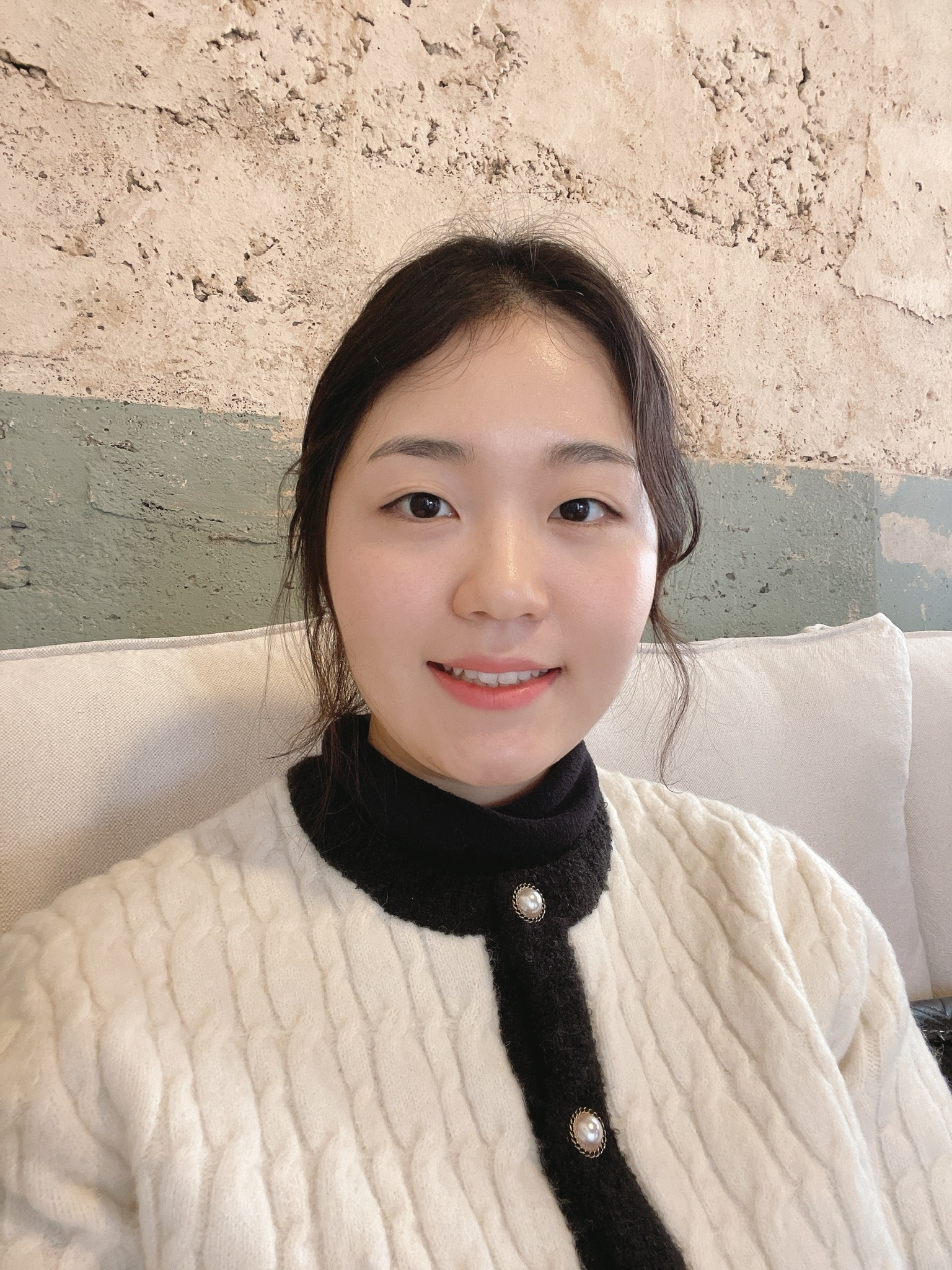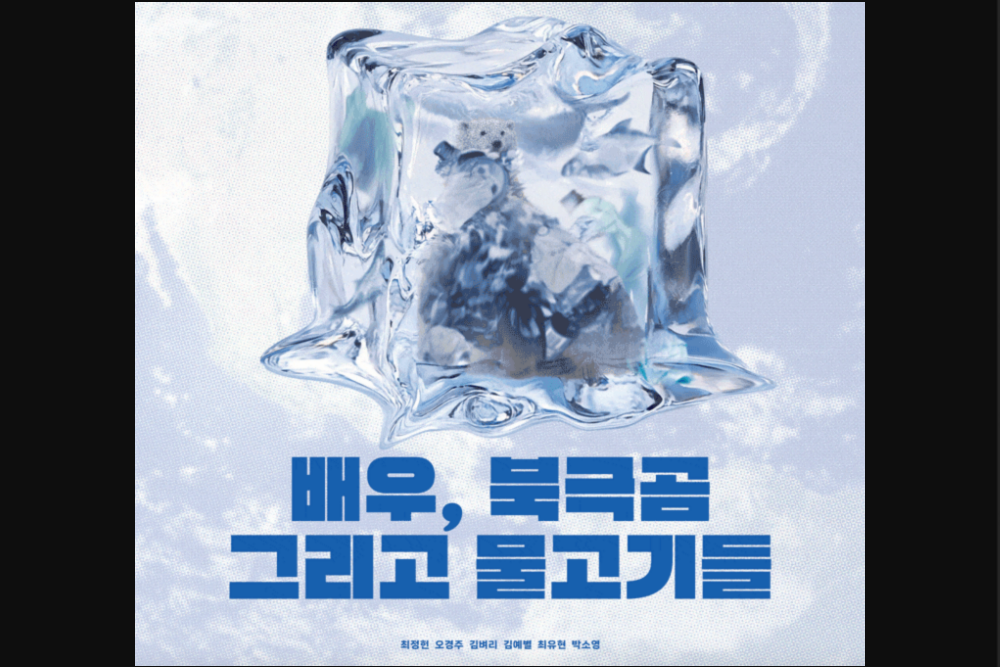1. Sustainable Art
Art Exhibition for Carbon Neutrality
Recently, in the art world, people from various fields gathered at museums to share concerns and initiate discussions on what museums, facing climate change, should contemplate and practice. The International Committee for Museums and Collections of Modern Art (CiMAM) has been encouraging global museums to participate since 2022 by developing a Museum Practice Toolkit that considers sustainability from social, economic, and environmental perspectives and aligns with the UN’s Sustainable Development Goals (SDGs). The CiMAM Sustainable Museum Practice Toolkit aims to support contemporary museum professionals in implementing sustainable practices in their institutions and individual work. Through this, it facilitates the necessary changes to promote social, economic, and environmental sustainability. The toolkit is structured around the environmental, social, and economic aspects of sustainability for museums.
1. Immediate Actionable Examples
2. Sustainability Action Plan
3. Carbon Footprint Calculator and Certification
4. Sustainability Consultant
5. Inspiring Projects, Platforms, and Resources
6. Recommended Reading List
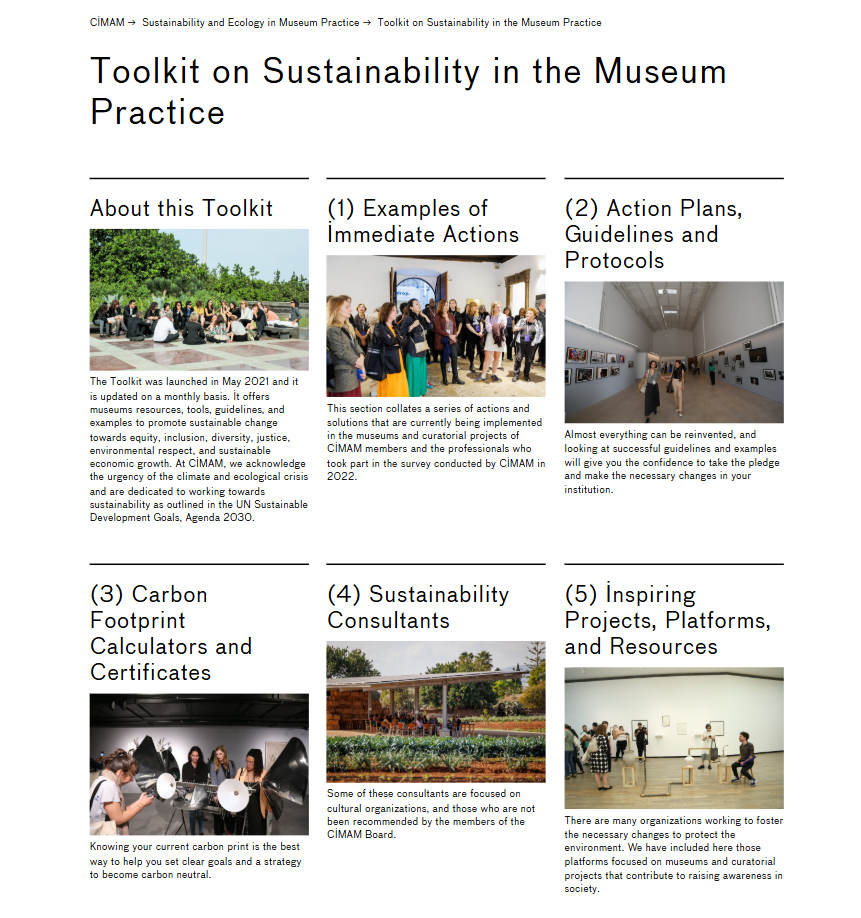
(Source: CiMAM)
The Arko Art Center, under the Korea Arts & Culture Foundation, has created the “Essential Environmental Practice Manual” for eco-friendly museums in response to the accelerating climate crisis following the pandemic. This manual was developed in alignment with the importance of sustainability highlighted by the International Council of Museums (ICOM) and CiMAM, as well as the United Nations. It was based on the CiMAM Sustainable Museum Toolkit and the “Veganism Exhibition Manual” from the public project “Art of Zero,” which opposes animal exploitation for various reasons. The Arko Art Center implements essential environmental practices as a “Sustainable Museum,” focusing on accessibility for diverse users, participation programs, barrier-free initiatives, and climate response. This report aims to explore the sustainable programs at the Arko Art Center and share insights on the growing movement for carbon neutrality within the art world.
A Similar Case: The ACE Environmental Program in the UK
ACE (Arts Council England) introduced an environmental program as a condition for arts funding for the first time in 2012. By encouraging organizations to report on their environmental impact from energy and water usage and to establish environmental plans, ACE became the world’s first arts funding body to incorporate environmental sustainability into its major support programs. As a result, the city of London required National Portfolio Organisations (NPOs)—such as theaters, art galleries, museums, and festivals, which receive long-term and multi-year funding—to measure and report on their environmental impact. NPOs were particularly suitable targets for the environmental program due to the substantial scale of public funding they receive (ranging from a minimum of £40,000 to an average maximum of £1,000,000), as well as their significant energy consumption in facility and program operations, making them responsible both socially and environmentally in terms of carbon reduction within the cultural sector.
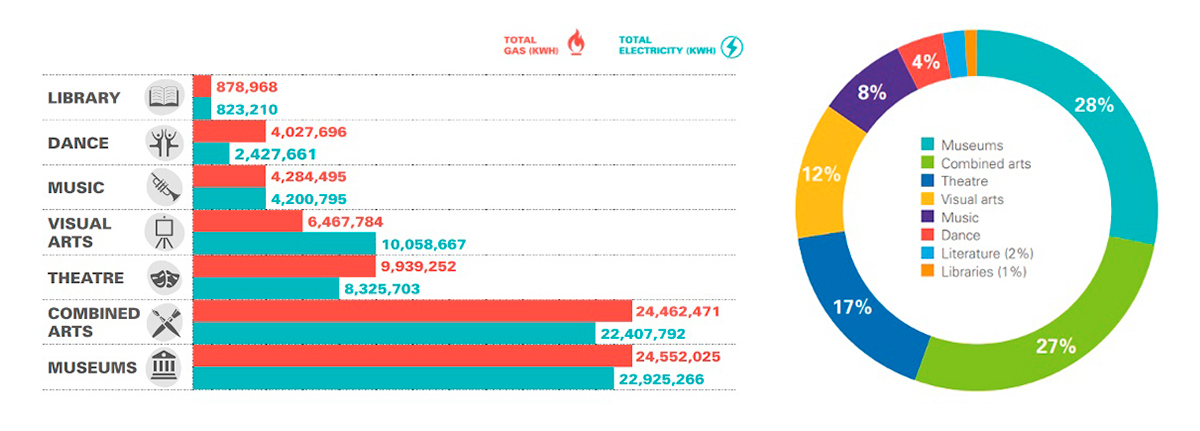
(Source: ARKO Art Center, 2023.11.)
The purpose of the environmental program is to: ① support NPOs in reporting on and submitting environmental plans as a condition for funding, ② showcase positive environmental changes and values within the cultural sector, and ③ develop the capacity of the Arts Council itself to support and drive these changes. This collaboration between the public sector’s support and the private sector’s professional services is creating a climate-art ecosystem. Based on this foundation, about 91% of NPO organizations agree that ACE’s environmental program has brought or can bring positive changes to their organizations (such as financial benefits like cost savings, 45%, and improved image, 44%). Such programs are similar to the way the Korea Arts & Culture Foundation, established to support the promotion of arts and culture, aids artists.
2. Sustainable Museum, ARKO Art Center
Efforts for a Sustainable Museum
The Arko Art Center started as the Art Hall in 1974 and was reborn in 2005 as the Arko Art Center, named after the English designation of the Korea Arts & Culture Foundation. Operating under the Korea Arts & Culture Foundation, Arko Art Center serves as a platform that conducts research, creation, exhibitions, and exchanges to discover and share the value of visual arts in response to the changing art environment during a period of social transformation, in line with the Foundation’s vision of being a “partner of the cultural and artistic field.” The Arko Art Center has incorporated its declared commitment and specific methods for enhancing environmental sustainability, accessibility, and inclusiveness into its manual as part of its efforts toward a “Sustainable Museum.”
Creation of a Sustainable Museum Operation Manual
Since 2020, Arko Art Center has set four key priorities: 1) “Expanding Museum Accessibility and Social Roles (+)”, 2) “Creating an Inclusive Environment Free from Hatred and Discrimination and Reducing Carbon Footprint (-)”, 3) “Generating Post-Pandemic Art Discourses through Interdisciplinary Collaboration (×)”, and 4) “Sharing Knowledge and Resources among Various Artistic Entities and Promoting Communication (÷).” These priorities are adopted not only for exhibitions and public programs but also as the fundamental direction for the overall operation of the museum. Among these, the commitment and specific methods for enhancing ‘environmental sustainability,’ ‘accessibility,’ and ‘inclusiveness’—as part of the sustainable museum practices—were discussed, reviewed by experts, and included in the manual. Starting with the first phase, the “Essential Environmental Practice Manual,” Arko Art Center plans to expand its sustainable museum operation guidelines, aiming for equality, human rights, cultural diversity, and a barrier-free museum. The Sustainable Museum Operation Manual is shown in Table 1 below.
| 1 | The exhibition will run for a minimum of 3 months and 2 weeks to ensure a long-term display – The frequency of exhibition installation and dismantling will be reduced. |
| 2 | Exhibitions will be designed to minimize the amount of materials used for spatial setup. – Minimize the installation of partition walls and materials. |
| 3 | During exhibition setup, display cabinets, partition walls, and other furniture and fixtures from previous exhibitions will be reused or recycled as protective materials. – By sharing the spatial plan, reusable partition walls will not be dismantled. – Reusable items such as viewing chairs and furniture will be reused. |
| 4 | For works by international artists, installation will be done remotely as much as possible without the artist or external curators visiting the site. – The artwork production manual will be provided, and the artwork will be created and exhibited in accordance with the manual within the country. |
| 5 | The carbon footprint of transportation and movement will be minimized as much as possible. – Collaborate with local partners and creators as much as possible.. |
| 6 | Reduce the use of adhesive films. – Create calligraphy/handwritten signs or explanatory boards to replace the use of adhesive films. – Provide audio guides. |
| 7 | Reduce the use of single-use items during various museum events and program operations. – Use reusable containers as much as possible, and when single-use items are necessary, opt for items that are recyclable and can be sorted for waste separation. |
| 8 | Decompose and sort exhibition waste or discarded materials, and donate them to relevant organizations or institutions. – Establish a pool for each type of material, such as wood recycling organizations and metal scrap supply organizations, to facilitate collaboration. |
| 9 | Implement workshops and educational programs to raise environmental awareness. – Plan related programs for each exhibition. – Operate regular public programs for different target groups, such as children and adults. |
| 10 | Collaborate with public and private organizations to achieve essential environmental missions and enhance awareness of environmental issues. – Collaborate with exhibition spaces and organizations to share resources or engage in mutual reuse. – Hold a roundtable with museums/galleries that share an eco-friendly mindset to discuss carbon reduction and environmental awareness. |
| 11 | Recycle leaflets through collection and reduce the quantity of leaflets. – Use eco-friendly paper and ink whenever possible. – Collect leaflets not taken after the visit, sanitize them, and reuse them. |
| 12 | Reduce promotional print materials such as invitations and posters, and distribute them digitally. – We will send promotional letters and invitations for the exhibition opening via email. – The exhibition posters will be printed in a minimal quantity for archiving purposes at the museum. |
| 13 | When producing publications such as catalogues, we aim to replace them with online versions (such as web catalogues) whenever possible and reduce the number of printed copies. – Both web and printed catalogues will be published; however, only a minimal number of printed catalogues will be produced. |
| 14 | The production of banners will be reduced. – We are considering replacing banners with digital media. – When producing banners, environmentally friendly materials (such as Tyvek or fabric) will be used. – After the banners are taken down, they will be recycled into items such as eco-bags whenever possible. |
| 15 | LED lighting will be used. – Fluorescent lights will be replaced with LED lighting. |
| 16 | We will reduce the energy consumption of the exhibition screening equipment. – High-efficiency equipment will be used. – Timers will be used to automate ON/OFF functions. |
| 17 | The walls will be continuously maintained to enable screening without the need for additional partition walls. – Wall maintenance is carried out every two years. |
| 18 | Water usage will be conserved in public restrooms and other facilities. – Sensor-activated faucets or water-saving devices will be installed. |
| 19 | An inventory of stored items will be created, and the recyclability of each item will be shared to enable efficient management. – Storage spaces will also be regularly updated to monitor their capacity and avoid overcrowding. – Common items used in exhibitions will be designed neutrally so they can be utilized across multiple exhibitions annually. |
<Table 1> Sustainable Museum Operations Manual — Stage 1: Eco-Friendly Practices
(Source: ARKO Art Center, 2023)
Eco-friendly Practices in Exhibition Management
Arko Art Center has reduced waste to promote sustainable museum operations by reusing partition walls for exhibition setups and recycling modules and screens. Eco-friendly banners were upcycled into eco-bags, and promotional postcards and invitations for exhibition openings were sent via email. Additionally, production of installation works was carried out remotely, and artworks by overseas artists were produced domestically, thereby reducing carbon emissions from air transportation.
The 2024 collaborative exhibition between Arko Art Center and the Regional Cultural Foundation, 《Here, the Reached Song》, showcased disabled art while producing the leaflet on eco-friendly recycled paper and minimizing the use of partition walls. By reducing the number of partition walls, the amount of materials used for spatial design was also decreased.

(Source: ARKO Art Center)
The thematic exhibition 《Into the Rhythm: From Score — Contact Zone》 is a collaborative project between On Curating, a nonprofit organization based in Zurich, Switzerland, and Arko Art Center. Exhibition structures and screens were recycled, and the production of partition walls was minimized by using colored wall surfaces to reduce material usage. As part of the 《Into the Rhythm》 related programs, the Green Recipe Lab organized and operated initiatives focused on sustainable practices.

(Source: ARKO Art Center)
The residency international artist invitational exhibition 《My Friend, My Home》 featured seven overseas artists and their colleagues, focusing on the theme of friendship and hospitality experienced in Korea during their residency. For this exhibition, modular furniture and exhibition screens from previous shows were reused. The space was designed using brick materials to minimize woodworking, and the bricks are planned to be reused. Additionally, some installation works by the artists were produced remotely, helping to reduce carbon emissions.

(Source: ARKO Art Center)
Arko Art Center has implemented an eco-friendly practice manual and improved internal systems to ensure that artworks are not consumed merely as one-time viewing experiences. As a result, total printed materials were reduced by over 60% compared to the previous year, and 90% of exhibition fixtures were recycled compared to the prior year. Additionally, automatic ON/OFF functions were fully applied to media equipment used in exhibitions to save energy. Furthermore, carbon emissions were reduced through facility upgrades such as water-saving faucets and LED lighting as part of space improvements.
Exhibition artworks on the theme of environment and climate change
Arko Art Center identified social issues such as climate change, ecology, environment, mobility, locality, and community—topics that gained prominence due to the pandemic—as themes for its exhibitions. Resulting exhibitions include 《The World of Transversal Matter》, which assumes the interconnectedness between humans and the environment; 《Hong Ihyeonsuk: Cross, Choo-Poo》, focusing on ecological perspectives; and 《Jung Jaecheol: Love and Peace》.
Arko Art Center’s 2022 thematic exhibition 《Temporary Intervention》 was a collaborative project between ‘Eodigadeun,’ a social enterprise focused on environmental issues and resource circulation, and ‘Piece of Peace,’ an artist collective of cultural and artistic workers in Korea. After the exhibition concluded, 26 wooden tables, carpets, shelves, pedestals, soil, and other materials and objects were recycled. Piece of Peace collected the furniture and carpets used in the exhibition for resale or refurbishment, while soil was distributed through an event where participants could apply to receive it. The soil, called ‘cocopite,’ made from crushed coconut shells, was used as bedding for abandoned hamsters or for repotting plants, and any remaining soil was sent to farms partnered with Eodigadeun.
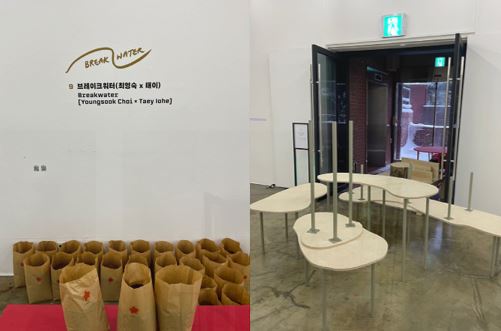
(Source: ARKO Art Center, 2023)
3. Industry Efforts for Sustainable Art
Carbon Emissions Assessment of the National Museum of Modern and Contemporary Art
The National Museum of Modern and Contemporary Art (MMCA) assessed carbon emissions generated by various exhibition-related activities. From August 19 to October 30, 2022, individual projects were planned under the 《Museum-Carbon Project》. This project included discussions on MMCA’s carbon emissions, sustainable art practices and materials, environmental impacts of art materials, art museums in the era of climate change, and museum ESG (Environmental, Social, and Governance). It also featured audience-participation workshops such as the materials workshop 《Meeting the Materials of the Future》 aimed at sustainable art practices. These discussions, the carbon emissions assessment process and results related to exhibition production at MMCA, and presentations from the project were compiled and published as a report.¹
The National Museum of Modern and Contemporary Art (MMCA) decided to assess greenhouse gas emissions generated during the processes of creating exhibitions and operating the museum in order to gauge the museum’s environmental impact. MMCA Seoul presents approximately 12 exhibitions annually. Among these, four exhibitions held in the past two years were selected for the study: a painting exhibition by a domestic artist, a video installation by an overseas artist, an international group exhibition held immediately after the COVID-19 outbreak, and an international group exhibition during the easing of social distancing measures. To calculate carbon emissions, exhibition-related activities were categorized as artwork production, business trips for the exhibition, packaging and transportation of artworks, exhibition space construction, promotional material production, energy use in the exhibition hall, visitor transportation, artwork removal, and exhibition-related waste disposal. However, emissions could not be calculated when materials lacked emission factors or usage data. Additionally, artistic activities conducted off-site by artists were excluded from the emission sources. The exact resource use for individual exhibitions was not fully known, making the museum’s carbon emissions estimates approximate. Other museums face similar challenges. Despite difficulties in carbon emissions calculation due to data collection limits and numerous variables, this assessment is significant in that it provides a fundamental baseline for considering the museum’s environmental impact and exploring realistic solutions.
Collaboration with Overseas Art Institutions
Domestic art museums and galleries are exploring multifaceted collaborations with overseas art institutions and organizations to address climate change. While preparing the exhibition 《Sustainable Museums: Art and Environment》, Busan Museum of Modern Art joined the Gallery Climate Coalition (GCC). To reduce carbon emissions, the exhibition implemented practices such as using modular walls, measuring power consumption of media artworks, opting for sea freight instead of air transport, excluding transportation by live-streaming exhibitions from overseas museums, and distributing catalogs online. The Gallery Climate Coalition is a nonprofit organization dedicated to reducing the environmental impact of activities in the art sector. Aiming to cut carbon and waste emissions in the arts by 50% by 2030, the coalition provides its members with a proprietary carbon calculator free of charge and shares best practices for waste reduction and resource recycling.
Yoon Hoseop’s ‘Green Canvas Exhibition’
I recently visited an exhibition by Yoon Hoseop, one of Korea’s first-generation graphic designers and the country’s pioneering green designer. His approach to exhibitions offers a promising example and direction for achieving carbon neutrality in the future art world, which is why I’d like to introduce it.
As a green designer, Yoon Hoseop embodies the values of green design not only in his themes but also throughout the production process. For example, in his first solo exhibition in the 2000s, he created the poster Dolphin, Human, Bird by hand-painting directly onto newspaper instead of using printing processes that cause environmental pollution. Additionally, he used environmentally friendly, non-toxic paints.

The recent exhibition 《Green Canvas》 in DDP featured around 100 paintings of the endangered Jeju southern bottlenose dolphins along a 170-meter-long corridor in the DDP exhibition hall. The life-sized artworks were created using eco-friendly paint and sustainable fabric. After the exhibition, all the pieces will be donated to Hotpink Dolphins, an environmental organization dedicated to dolphin conservation in Jeju.
At the DDP exhibition hall, a participatory artwork was created by placing balls made from discarded tape and PET bottles filled with soil to instill a sense of green DNA in visitors. The corrugated cardboard cushions, made by layering cardboard and stitching it together with twine, were originally produced while preparing for the artist’s first solo exhibition in 2000 and have been used for over 20 years at various events both in Korea and abroad.
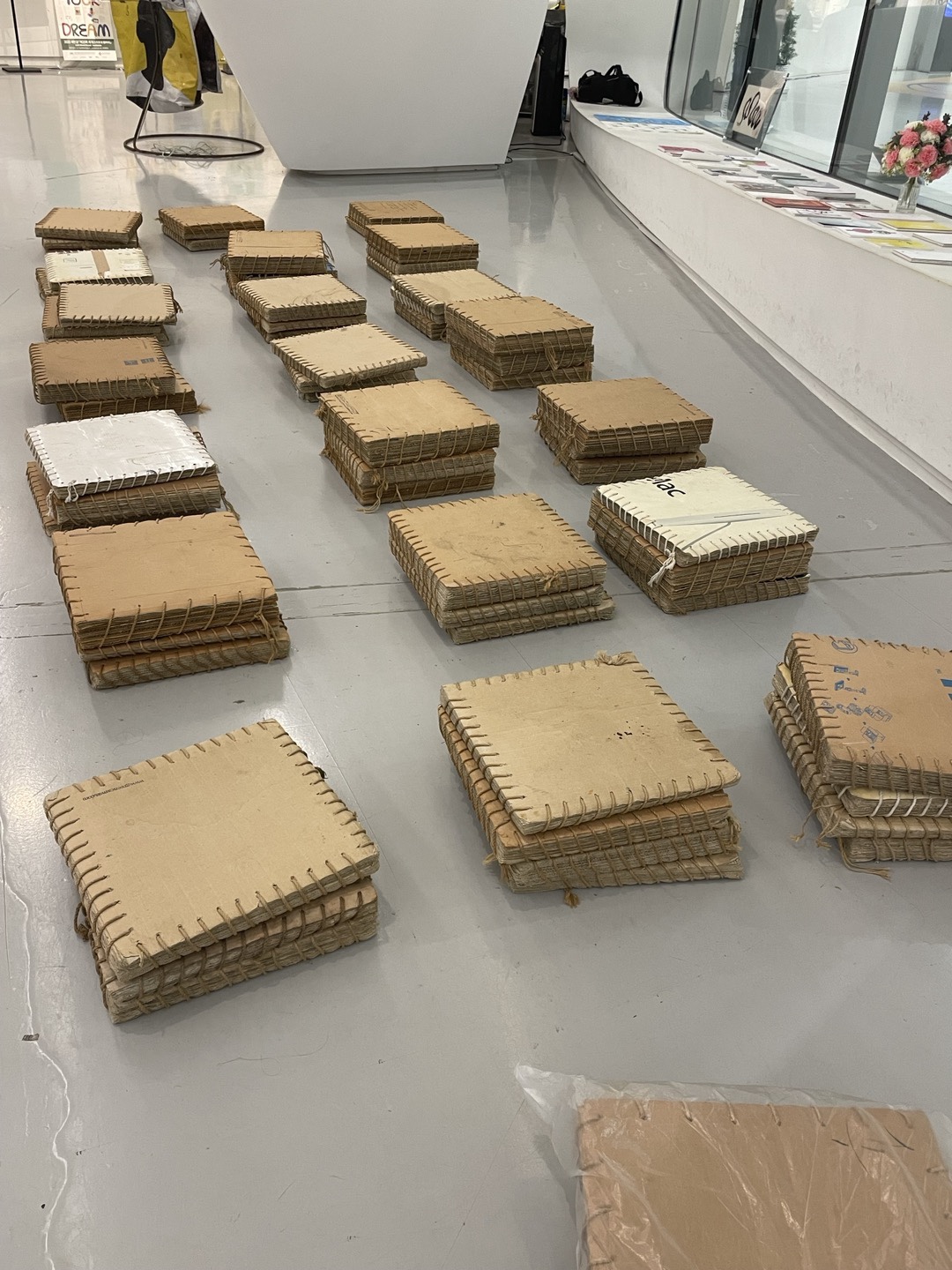
4. Conclusion: Achieving Carbon Neutrality in Museums through Integrated Efforts
Museum Innovation
Haitham Eid, author of 『Museum Innovation』, defines museum innovation as “achieving social significance and sustainability through proactive response and active engagement with social issues.” According to Geunhye Lim, director of Arko Art Center, the center’s ‘Sustainable Museum Practice Manual’ aligns closely with the awareness and practical strategies of this museum innovation.¹ Like the hope that ARKO Art Center’s sustainable museum manual will serve as a virtuous cycle—listening to voices from the art field, sharing new questions and discoveries with others—it represents a new path toward an eco-friendly sustainable exhibition culture. It is expected that more stakeholders in the exhibition arts community will follow this approach and strive toward carbon neutrality.
Museum Carbon Neutrality from an Integrated Perspective
Achieving carbon neutrality in museums depends not only on the efforts of the museums and artists themselves but also, importantly, on the participation and actions of the visitors. Only when visitors understand carbon neutrality can these efforts gain wider recognition and gradually expand throughout the art world. Furthermore, such progress must be supported by effective arts policies. Kwon Yongmin, senior researcher at the Korea Arts & Culture Education Service, conducted a survey on artists’ awareness of climate change from 2021 to 2023, gathering responses from 559 applicants to support programs under the National Culture and Arts Support System (NCAS). The results showed a relatively high level of awareness regarding the role of arts policy in addressing climate change. They also indicated that support for creative works on related themes and climate action activities should be prioritized. Based on these findings, Researcher Kwon emphasizes the need to explore the roles of art and arts policy from an integrated perspective.
Although there is no consensus yet on what constitutes cultural and arts policies reflecting the climate change agenda, an examination of policies from countries and arts funding institutions abroad reveals two main directions. First, under the global goal of carbon neutrality (Net Zero), efforts are made to reduce the ecological footprint of the cultural and arts sector, with each country implementing environmental cultural policies according to its national will and circumstances. Second, there is support for cultural approaches that enable citizens to perceive climate change, explore alternatives, and participate in environmental actions. Through cultural engagement in spaces such as museums, libraries, art centers, and everyday environments, people can gain a more accessible and effective understanding of climate change and collectively imagine pathways toward transformation.
In the cultural and arts sector, there are cases where the good intentions behind sustainability efforts are undermined by the very ways artworks are produced, or where superficial sustainability is pursued by focusing solely on substituting resources and fuels. If there is an alternative direction for sustainability practices in the arts, it lies in using artworks to encourage people to reflect on environmental issues as personal matters and to create practical ways to act within their own spheres. Thus, achieving carbon neutrality in museums requires not only the independent efforts of artists and museums but also integrated cultural and arts policies, alongside shifts in public awareness and behavior. Through this combined approach, museums can move steadily toward carbon neutrality.
Footnote
- The National Museum of Modern and Contemporary Art’s 2022 «Museum-Carbon-Project»in the realm of multidisciplinary art does not aim to present specific solutions or policies regarding climate change and carbon neutrality. Instead, the project and its accompanying publication seek to raise and confront the complex and unresolved question of what it means to be a sustainable museum.
References
- 국립현대미술관 (n.d) 국립현대미술관 다원예술 2022: 미술관-탄소-프로젝트.
- 나혜영 (2022) 영국예술위원회의 환경적 책임 강화, 주요 흐름과 시사점, 아키스브리핑 제321호.
- 노컷뉴스 (2022.10.08) 미술계 기후대응…친환경 매뉴얼 만들고 재활용하고.
- 서울신문 (2024.01.09.) 장애·돌봄 등 전시로 발굴… 지속가능한 미술관 그려요.
- 아르코미술관 (2023) 지속가능한 미술관 운영 매뉴얼 1단계: 필(必) 환경 실천.
- 한국섬유신문 (2024.10.02.) [오피니언기고] 시대를 읽어내는 디자인.
- A SQUARE (2023.11.) 기후 변화 예술 활동에 대한 예술인 인식조사.
- A SQUARE (2023.11.) 지금, 환경 아젠다를 진지하게 고민해야 할 때.
- A SQUARE (2023.11.) 친환경 예술의 이면, 문화예술계 그린워싱.
- CiMAM Official Homepage. About the Toolkit on Sustainable Museum Practices.
- Design+ (2024.07.30.) 디자인으로 녹색 DNA를 심다, 윤호섭 디자이너.
- MBN (2023.03.11.) 미술계 탄소 중립은?…”올해 5~6월, 지속 가능한 미술관 매뉴얼 공개” [김기자의 문화이야기].
Suggested Reading


